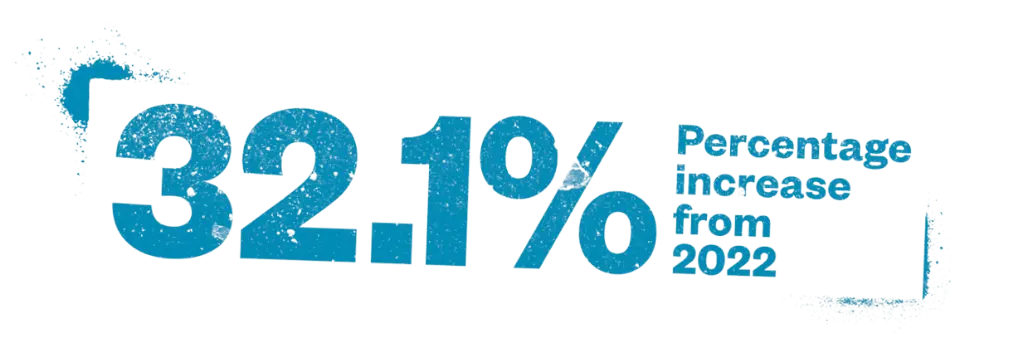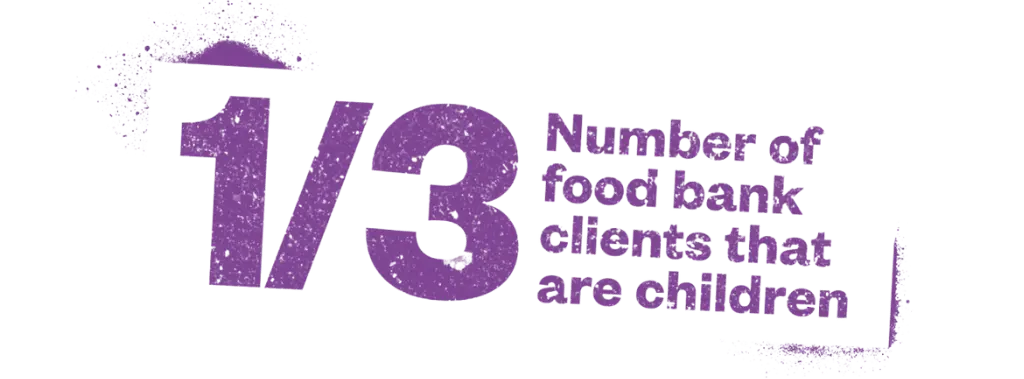OVERALL FINDINGS
In March 2023, there were over 1.9 million visits to food banks in Canada, far surpassing last year’s usage, which set a record at the time.
Food bank visits in March 2023 were at an unprecedented level. The number of visits far surpassed last year’s record-breaking number, despite unemployment rates holding at a steady low during that same period. This record level of usage is consistent with findings from other studies referenced in this report that show increasing numbers of people in Canada are struggling to pay for basic expenses, and that levels of food insecurity are rising dramatically.

This year’s food bank usage represents a 32 per cent increase compared to March 2022, and a 78.5 per cent increase compared to March 2019.
Overall, food bank visits have increased at greater and greater rates since 2019, with the highest year-over-year increase in usage ever reported this year. This increase coincided with the highest rates of general inflation in 40 years—and the cost of essentials such as food, shelter, and transportation soared at even higher rates. As the purchasing power of households continues to drop, more households, including those in higher income brackets, are experiencing food insecurity.

According to survey respondents, the top reasons people accessed a food bank this year were food costs, housing costs, and low wages or not enough hours of work.
People accessing food banks in Canada are more likely to be in the lowest income bracket and are therefore particularly affected by any increase in food prices. When all factors are considered, the rising cost of food is only the tip of the affordability iceberg in terms of the cost challenges faced by those in the lowest-income households. Limited financial resources and housing costs that are well over the affordability threshold of 30 per cent of one’s income mean those living with low incomes are less likely to be able to manage food inflation and more likely to experience food insecurity. In addition, people working in the lowest-paying jobs were less likely to have seen any increase in wages during the year and were more likely to be working in industries where part-time work is the norm.
One third of food bank clients are children.
The percentage of children under 18 accessing food banks has held steady since the pre-pandemic period, and currently comprise 33 per cent of food bank clients. However, children are still greatly over-represented in food bank client numbers, as they represent only 20 per cent of the general population. Since the start of the pandemic, households with children have been more likely to experience food insecurity, and there has been an increase in two-parent households with children under 18 accessing food banks—from 18.8 per cent in 2019 to 21 per cent in 2023. Food bankers mentioned that families with children are struggling with the combination of high housing, food, and fuel costs, in addition to the costs of childcare and other child-specific needs. Those struggling include many recent newcomers who are employed but are not receiving enough hours to make ends meet or are in precarious employment.

The most common income source for food bank clients is provincial social assistance.
The main source of income for 42.4 per cent of food bank clients is provincial social assistance, which includes both the general welfare and provincial disability support income streams. Provincial social assistance rates are so low that all household types receiving social assistance live below the official poverty line in almost every province and territory. In many cases, the real dollar value of these rates has barely risen compared to 30 years ago—and in some cases has actually declined.
In addition to low rates, there are very strict eligibility requirements to access provincial social assistance in most provinces and territories, including dollar-for-dollar clawbacks for applicants with any employment income and very low liquid asset limits to qualify for support. These rules had significant implications post-pandemic. Food bankers mentioned that clients who received provincial social assistance and qualified to receive income from the CRB were subject to clawbacks and federal taxes, in addition to having other tax benefits (such as child benefits and GST credits) reduced due to their temporarily increased income in the previous year.

People receiving provincial disability support represent 13.6 per cent of total households accessing food banks.
While the proportion of clients receiving provincial disability support as their main source of income has declined compared to before the pandemic, this decline is not due to a decreased need among people with disabilities but rather to increases in the proportions of households with other main sources of income. People with disabilities have been experiencing disproportionate levels of hardship because the costs of their higher health care needs are compounded by the effects of rapid inflation. Among the general population in 2023, 28 per cent of people with a physical disability and 39 per cent with a mental disability reported going hungry in the previous 12 months because of lack of money for food, compared to 10 per cent of people without a disability.

17 per cent of food bank clients report employment as their main source of income, compared to 12 per cent in 2019.
After over a decade of hovering between 11 per cent and just over 12 per cent, the percentage of food bank clients whose main source of income is employment has increased significantly since 2021. This group now represents nearly 17 per cent of food bank clients—the highest proportion ever. This increase coincides with the significant increase in racialized groups accessing food banks in the last year—from 32.5 per cent in 2022 to 39.3 per cent in 2023. Racialized groups are more likely to be working poor than non-racialized groups, and according to Statistics Canada, were more likely to be earning lower than average hourly wages and working part-time hours in 2022. Racialized groups who were employed throughout the pandemic were also more likely than non-racialized groups to have needed to access a food bank or similar program during that time.

The percentage of Indigenous people accessing a food bank is 12 per cent, even though they represent only 5 per cent of the general population.
The percentage of Indigenous people accessing a food bank is 12 per cent in 2023—even though they represent only 5 per cent of the general population. With income-based poverty rates nearly double those of the non-Indigenous population, First Nations, Métis, and Inuit people experience the compounded effects of low income and the challenges of managing inflation rates for basic needs that exceed what is experienced by the non-Indigenous population. Climate change has also impacted access—both market-based and traditional—to food among Indigenous communities. Among the general population in 2023, nearly half (48%) of people who are Indigenous reported having gone hungry in the previous 12 months due to lack of money for food, compared to 15 per cent of the white population.

26.6 per cent of food bank clients are newcomers to Canada who have been in the country for 10 years or less.
The proportion of recent newcomers to Canada accessing food banks significantly increased from last year—when they comprised 17.2 per cent of food bank clients—and has more than doubled compared to 2016—when they comprised 12.5 per cent of clients. Recent newcomers are more likely to be working poor than people who are not recent newcomers—they are more likely to have unstable jobs, unpredictable work hours, and fewer benefits such as drug and dental insurance. Recent newcomers are also more likely to be renters, which means they are likely paying higher median shelter costs and more than 30 per cent of their income on housing. The combination of these factors leaves them particularly vulnerable to the impacts of rapid inflation. Furthermore, newer arrivals fleeing war in their home countries face extreme challenges finding affordable housing and varying levels of government support depending on their immigration status.

